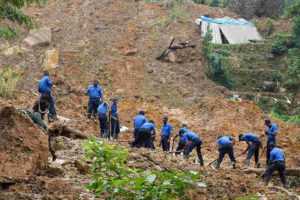13 Contour Farming Advantages and Disadvantages Explained
Contour farming advantages and disadvantages are; erosion control, cost reduction, improved fertility, biodiversity, biomass accumulation, improved water quality, hazard mitigation (advantages); labor, low adoption, feasibility, suitability, low production potential, weed control challenges, lack of equipment, knowledge and awareness (disadvantages).
These are discussed as follows;
-Contour Farming Disadvantages
Contour Farming Advantages
1). Erosion Control
Contour farming (also strip farming, contour cropping, contour cultivation, terrace farming, or terracing) is one of the simplest and most effective sustainable farming approaches that are used to control erosion [5].
When agricultural practices are carried out along the contours of a sloping land area, the impact of erosion is significantly reduced. Some estimates suggest that contour farming can reduce erosion by up to 50% [2].
Because of its erosion-control characteristics, terracing is applied as one of the methods of soil conservation. It is also recommendable to reduce the risk of environmental degradation by soil loss and land deformation.
Physical features produced on sloping land in the course of contour farming, are responsible for reducing erosion. These include ridges, soil strips and vegetation barriers.
The function of these structures is to act as physical blockades to water and wind which flows down the slope. As these moving fluid streams collide with the blockades, they are weakened and lose their velocity and ability to transport soil particles or cause significant damage.
2). Cost Reduction
There are various ways in which contour farming reduces the cost of crop production.
One of these is through the conservation of soil fertility. Because contour cropping reduces loss of fertility through erosion and leaching, it reduces the need for fertilizer application. Reduced fertilizer demand means lower production cost.
Contour farming also reduces crop production cost by protecting crop species and water resources. This lessens the need for new seeds and irrigation, along with the costs of these measures.
Lastly, contour farming eliminates the need and cost of soil restoration, by conserving land resources and mitigating the risk of degradation.
3). Improved Fertility
Contour farming can improve soil fertility through various means.
When erosion and leaching are reduced, the rate of loss of nutrients from the soil decreases. This contributes to a boost in overall fertility.
Moisture content of soil is increased through contour farming [11]. This occurs because runoff becomes restricted by the ridges and vegetation barriers, thereby allowing more water to infiltrate the soil.
The above outcome is particularly beneficial for soils that have been affected by drought and desertification.
When moisture content of soil increases, biological processes and organisms in the soil become more active [3]. This leads to accumulation of biomass, and rapid biodegradation which provides nutrients to the soil. Organic activities also improve soil structure, as can be measured in terms of porosity, permeability and aeration [8].
Contour farming also increases the effectiveness of some fertility-optimization measures like composting and fertilizer application, by conserving soil and preventing leaching. In some cases it is recommendable to practice contour cropping alongside other sustainable agricultural techniques like crop rotation and cover cropping.
4). Biodiversity and Biomass Accumulation
Contour farming increases the amount of organic matter in soil [1].
This occurs due to the conservative nature of the method, which allows organic matter to accumulate on (and in) soil without being lost to erosion or leaching.
By reducing soil disturbance, contour cropping increases the concentration of carbon in soil, which is good for soil health. Storage of carbon in soil also reduces atmospheric greenhouse gases, and can contribute to the mitigation of climate change and global warming.
The presence of organic matter in soil also improves the health and productivity of the agricultural ecosystem, as can be evaluated through water and air quality, biodiversity, and the effectiveness of ecological cycles and hierarchies like the energy pyramid.
Practicing contour faming with no-till cultivation can further boost soil organic content.
5). Improved Water Quality
Contour farming leads to improved regional water quality because it reduces the impurities that are transported into water bodies by runoff [7].
Through the reduction of erosion and leaching, turbidity and sediment load of stormwater becomes less. When this water infiltrates streams, reservoirs or underground aquifers, it does not cause degradation.
Chemical pollution and eutrophication as a result of fertilizer leaching are also mitigated.
6). Hazard Mitigation
Terrace farming is known to mitigate the risk of natural hazards like flooding and landslides. By doing so, the method prevents damages, loss of lands and habitats [10].
When water runs off a contour-cultivated slope, the terraces or barriers reduce the velocity and power of the flowing water. They also allow the soil to absorb water at a consistent pace. These effects increase slope stability and reduce the risk of landslides.

Flooding is also reduced as a result of increased infiltration and water absorption.
Contour cropping is also capable of mitigating drought risk by increasing the moisture content and retention of soil [9].
Contour Farming Disadvantages
7). Labor Demand
It is important to consider the role of labor when discussing contour farming advantages and disadvantages.
Compared to the more conventional farming methods, terrace farming demands extra labor and time [4]. This is because of the complexity of cultivating along contour lines (areas of equal elevation or level), plowing, making ridges or hedgerows, planting and pruning.
Extra labor is a significant economic challenge, given the need to improve efficiency by achieving more productivity with less labor.
8). Low Adoption
Although the rate of adoption of contour cultivation around the world has increased in recent years, it is still relatively low.
A significant number of farmers in sloping land areas do not practice contour cultivation. The reasons for this include relative complexity and lack of adequate knowledge about the method.
Low adoption may be an indication of the need to improve how contour farming is practiced, to make it easier and more effective for farmers to adopt.
9). Suitability and Feasibility Problems
One of the disadvantages of contour cultivation is that it is not always a suitable or feasible method.
Various factors determine the suitability or feasibility of contour cultivation, such as climate, soil characteristics, regional drainage, knowledge, available labor and economic resources, specific relief or topographic conditions, and scale of farming.
Generally, the method is most suitable and feasible in small to medium-scale projects with sufficient labor and knowledge, and in regions with homogenous soil, non-extreme climate, and optimal drainage.
The selectiveness of contour farming can pose a serious challenge and may affect its adoption, practice and effectiveness, especially considering the importance of versatility in agriculture.
10). Production Potential may Decrease
Under some circumstances, the practice of contour cultivation may reduce potential productivity.
Reasons why this may occur include extra labor that is spent on vegetative barrier alignment (with contours), ridges and other technical factors; and the use of less land space for actual planting.
However, on a long-term basis, these production losses are regained by conservation of soil, water and nutrients.
11). Weed Control
It is believed that contour farming can be an effective way to control weeds.
However, weed control in terrace farms can be difficult. This is because of the sensitive nature of such farms, which restricts the possible measures that can be taken to control these weeds.
For example, chemical herbicides cannot be used extensively in terrace farms compared to conventional farms, because the risk of chemical pollution due to leaching and runoff is higher for sloping regions.
The presence of ridges and carefully-aligned vegetation also makes it difficult to remove weeds manually.
12). Lack of Equipment
Rows and ridges in terrace farming requires both labor and equipment.
However, access to suitable equipment is a challenge in this method of farming.
This is because many conventional agricultural equipment are not useful or effective for terrace farming. These include machines for ploughing, planting, harvesting, weed and pest control.
Many contour farmers depend on manual labor for most of their agricultural activities, which reduces productivity.

13). Lack of Knowledge and Awareness
Contour farming requires knowledge to identify contour lines, create vegetative barriers and ridges, cultivate crops, and maintain the farm.
Lack of knowledge in these areas can affect the productivity of contour cultivation projects [6].
Many farmers in sloping lands are also not aware of contour cultivation, or its effectiveness and benefits, or the consequences of erosion. The lack of awareness, knowledge and training are drawbacks of contour cultivation.
Conclusion
Contour farming advantages and disadvantages include;
Advantages
- Erosion Control
- Cost Reduction
- Improved Fertility
- Biodiversity and Biomass Accumulation
- Improved Water Quality
- Hazard Mitigation
Disadvantages
- Labor Demand
- Low Adoption
- Suitability and Feasibility Problems
- Production Potential may Decrease
- Weed Control
- Lack of Equipment
- Lack of Knowledge and Awareness
References
1). Abiye, W. (2022). “Soil and Water Conservation Nexus Agricultural Productivity in Ethiopia”. Advances in Agriculture, Available at: https://doi.org/10.1155/2022/8611733. (Accessed 25 July 2022).
2). Babubhai, S. H. (2018). “Cover Cropping and Contour Cultivation.” Available at: https://www.biotecharticles.com/Agriculture-Article/Cover-Cropping-and-Contour-Cultivation-4326.html. (Accessed 25 July 2022).
3). Borowik, A.; Wyszkowska, J. (2016). “Soil moisture as a factor affecting the microbiological and biochemical activity of soil.” Plant, Soil and Environment 62(No. 6):250-255. Available at: https://doi.org/10.17221/158/2016-PSE. (Accessed 25 July 2022).
4). Chapagain, T.; Raizada, M. (2017). “Agronomic Challenges and Opportunities for Smallholder Terrace Agriculture in Developing Countries.” Frontiers in Plant Science 8. Available at: https://doi.org/10.3389/fpls.2017.00331. (Accessed 25 July 2022).
5). Dorren, L.; Rey, F. (2004). “A review of the effect of terracing on erosion.” Available at: https://www.researchgate.net/publication/228581261_A_review_of_the_effect_of_terracing_on_erosion. (Accessed 25 July 2022).
6). Farahani, S.; Fard, F. S.; Asoodar, M. A. (2016). “Effects of contour farming on runoff and soil erosion reduction: A review study.” Available at: https://www.researchgate.net/publication/312054649_Effects_of_contour_farming_on_runoff_and_soil_erosion_reduction_A_review_study. (Accessed 25 July 2022).
7). Gathagu, J. N.; Mourad, K. A.; Sang, J. (2018). “Effectiveness of Contour Farming and Filter Strips on Ecosystem Services.” Water 10(10). Available at: https://doi.org/10.3390/w10101312. (Accessed 25 July 2022).
8). Grosbellet, C.; Vidal-Beaudet, L.; Caubel, V.; Charpentier, S. (2011). “Improvement of soil structure formation by degradation of coarse organic matter.” Geoderma 162(1):27-38. Available at: https://doi.org/10.1016/j.geoderma.2011.01.003. (Accessed 25 July 2022).
9). Kosmowski, F. (2018). “Soil water management practices (terraces) helped to mitigate the 2015 drought in Ethiopia.” Agricultural Water Management 204. Available at: https://doi.org/10.1016/j.agwat.2018.02.025. (Accessed 25 July 2022).
10). Mugagga, F.; Buyinza, M.; Kakembo, V. (2010). “Livelihood Diversification Strategies and Soil Erosion on Mount Elgon, Eastern Uganda: A Socio-Economic Perspective.” Environmental Research Journal 4(4):272-280. Available at: https://doi.org/10.3923/erj.2010.272.280. (Accessed 25 July 2022).
11). Ramanjaneyulu, A. V.; Nagula, S.; Sravanthi, D.; Ramana, M. V. (2020). “Contour Farming Improves Soil Moisture and Dry Land Crop Productivity on Rainfed Alfisols.” International Research Journal of Pure and Applied Chemistry 21(21):60-69. Available at: https://doi.org/10.9734/IRJPAC/2020/v21i2130290. (Accessed 25 July 2022).




